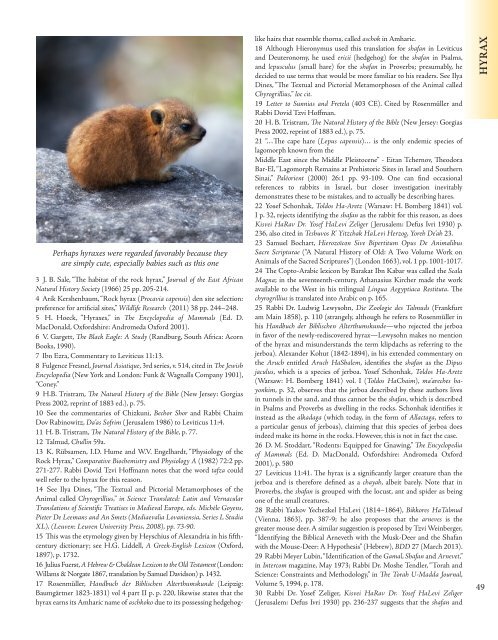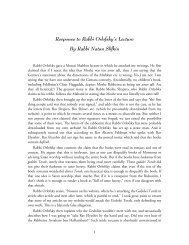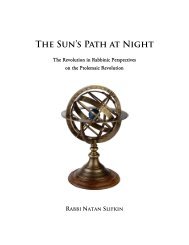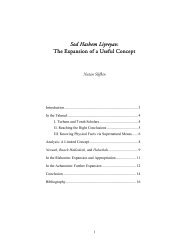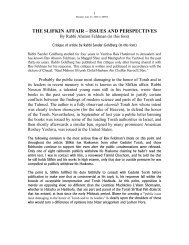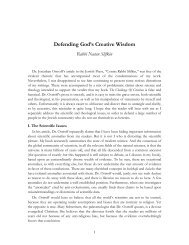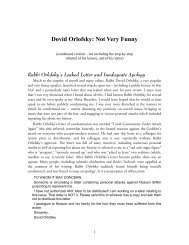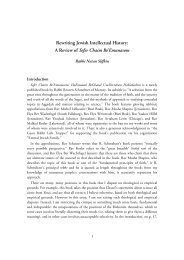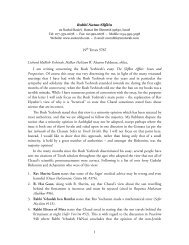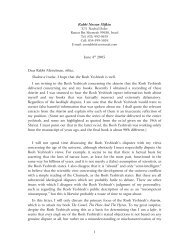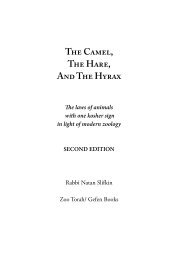You also want an ePaper? Increase the reach of your titles
YUMPU automatically turns print PDFs into web optimized ePapers that Google loves.
Perhaps hyraxes were regarded favorably because theyare simply cute, especially babies such as this one3 J. B. Sale, “The habitat of the rock hyrax,” Journal of the East AfricanNatural History Society (1966) 25 pp. 205-214.4 Arik Kershenbaum, “Rock hyrax (Procavia capensis) den site selection:preference for artificial sites,” Wildlife Research (2011) 38 pp. 244–248.5 H. Hoeck, “Hyraxes,” in The Encyclopedia of Mammals (Ed. D.MacDonald, Oxfordshire: Andromeda Oxford 2001).6 V. Gargett, The Black Eagle: A Study (Randburg, South Africa: AcornBooks, 1990).7 Ibn Ezra, Commentary to Leviticus 11:13.8 Fulgence Fresnel, Journal Asiatique, 3rd series, v. 514, cited in The JewishEncyclopedia (New York and London: Funk & Wagnalls Company 1901),“Coney.”9 H.B. Tristram, The Natural History of the Bible (New Jersey: GorgiasPress 2002, reprint of 1883 ed.), p. 75.10 See the commentaries of Chizkuni, Bechor Shor and Rabbi ChaimDov Rabinowitz, Da’as Sofrim ( Jerusalem 1986) to Leviticus 11:4.11 H. B. Tristram, The Natural History of the Bible, p. 77.12 Talmud, Chullin 59a.13 K. Rübsamen, I.D. Hume and W.V. Engelhardt, “Physiology of theRock Hyrax,” Comparative Biochemistry and Physiology A (1982) 72:2 pp.271-277. Rabbi Dovid Tzvi Hoffmann notes that the word tafza couldwell refer to the hyrax for this reason.14 See Ilya Dines, “The Textual and Pictorial Metamorphoses of theAnimal called Chyrogrillius,” in Science Translated: Latin and VernacularTranslations of Scientific Treatises in Medieval Europe, eds. Michèle Goyens,Pieter De Leemans and An Smets (Mediaevalia Lovaniensia, Series I, StudiaXL), (Leuven: Leuven University Press, 2008), pp. 73-90.15 This was the etymology given by Heyschius of Alexandria in his fifthcenturydictionary; see H.G. Liddell, A Greek-English Lexicon (Oxford,1897), p. 1732.16 Julius Fuerst, A Hebrew & Chaldean Lexicon to the Old Testament (London:Willams & Norgate 1867, translation by Samuel Davidson) p. 1432.17 Rosenmüller, Handbuch der Biblischen Alterthumskunde (Leipzig:Baumgärtner 1823-1831) vol 4 part II p. p. 220, likewise states that thehyrax earns its Amharic name of aschkoko due to its possessing hedgehoglikehairs that resemble thorns, called aschok in Amharic.18 Although Hieronymus used this translation for shafan in Leviticusand Deuteronomy, he used ericii (hedgehog) for the shafan in Psalms,and lepusculus (small hare) for the shafan in Proverbs; presumably, hedecided to use terms that would be more familiar to his readers. See IlyaDines, “The Textual and Pictorial Metamorphoses of the Animal calledChyrogrillius,” loc cit.19 Letter to Sunnias and Fretela (403 CE). Cited by Rosenmüller andRabbi Dovid Tzvi Hoffman.20 H. B. Tristram, The Natural History of the Bible (New Jersey: GorgiasPress 2002, reprint of 1883 ed.), p. 75.21 “…The cape hare (Lepus capensis)… is the only endemic species oflagomorph known from theMiddle East since the Middle Pleistocene” - Eitan Tchernov, TheodoraBar-El, “Lagomorph Remains at Prehistoric Sites in Israel and SouthernSinai,” Paléorient (2000) 26:1 pp. 93-109. One can find occasionalreferences to rabbits in Israel, but closer investigation inevitablydemonstrates these to be mistakes, and to actually be describing hares.22 Yosef Schonhak, Toldos Ha-Aretz (Warsaw: H. Bomberg 1841) vol.I p. 32, rejects identifying the shafan as the rabbit for this reason, as doesKisvei HaRav Dr. Yosef HaLevi Zeliger ( Jerusalem: Defus Ivri 1930) p.236, also cited in Teshuvos R’ Yitzchak HaLevi Herzog, Yoreh De’ah 23.23 Samuel Bochart, Hierozoïcon Sive Bipertitum Opus De AnimalibusSacre Scripturae (“A Natural History of Old: A Two Volume Work onAnimals of the Sacred Scriptures”) (London 1663), vol. 1 pp. 1001-1017.24 The Copto-Arabic lexicon by Barakat Ibn Kabar was called the ScalaMagna; in the seventeenth-century, Athanasius Kircher made the workavailable to the West in his trilingual Lingua Aegyptiaca Restituta. Thechyrogrillius is translated into Arabic on p. 165.25 Rabbi Dr. Ludwig Lewysohn, Die <strong>Zoo</strong>logie des Talmuds (Frankfurtam Main 1858), p. 110 (strangely, although he refers to Rosenmüller inhis Handbuch der Biblischen Alterthum skunde—who rejected the jerboain favor of the newly-rediscovered hyrax—Lewysohn makes no mentionof the hyrax and misunderstands the term klipdachs as referring to thejerboa). Alexander Kohut (1842-1894), in his extended commentary onthe Aruch entitled Aruch HaShalem, identifies the shafan as the Dipusjaculus, which is a species of jerboa. Yosef Schonhak, Toldos Ha-Aretz(Warsaw: H. Bomberg 1841) vol. I (Toldos HaChaim), ma’areches hayonkim,p. 32, observes that the jerboa described by these authors livesin tunnels in the sand, and thus cannot be the shafan, which is describedin Psalms and Proverbs as dwelling in the rocks. Schonhak identifies itinstead as the alkadaga (which today, in the form of Allactaga, refers toa particular genus of jerboas), claiming that this species of jerboa doesindeed make its home in the rocks. However, this is not in fact the case.26 D. M. Stoddart, “Rodents: Equipped for Gnawing,” The Encyclopediaof Mammals (Ed. D. MacDonald, Oxfordshire: Andromeda Oxford2001), p. 58027 Leviticus 11:41. The hyrax is a significantly larger creature than thejerboa and is therefore defined as a chayah, albeit barely. Note that inProverbs, the shafan is grouped with the locust, ant and spider as beingone of the small creatures.28 Rabbi Yaakov Yechezkel HaLevi (1814–1864), Bikkores HaTalmud(Vienna, 1863), pp. 387-9; he also proposes that the arneves is thegreater mouse deer. A similar suggestion is proposed by Tzvi Weinberger,“Identifying the Biblical Arneveth with the Musk-Deer and the Shafanwith the Mouse-Deer: A Hypothesis” (Hebrew), BDD 27 (March 2013).29 Rabbi Meyer Lubin, “Identification of the Gamal, Shafan and Arnevet,”in Intercom magazine, May 1973; Rabbi Dr. Moshe Tendler, “<strong>Torah</strong> andScience: Constraints and Methodology,” in The <strong>Torah</strong> U-Madda Journal,Volume 5, 1994, p. 178.30 Rabbi Dr. Yosef Zeliger, Kisvei HaRav Dr. Yosef HaLevi Zeliger( Jerusalem: Defus Ivri 1930) pp. 236-237 suggests that the shafan andHYRAX49


